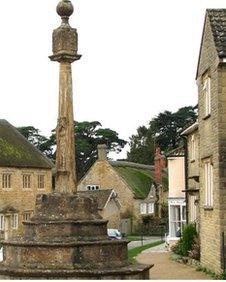Life expectancy among pensioners highest in Somerset village
- Published
- comments

Hinton St George is "a lovely place to live"
The great variation in life expectancy among pensioners has been highlighted in a new study by the actuarial firm Towers Watson.
Male pensioners aged 65 in the small Somerset village of Hinton St George, population 400, have the highest life expectancy in the UK, at 88.7 years.
Those with the lowest life expectancy live in Bootle on Merseyside.
The study was based on mortality rates among 1.5 million retired people in 51 final-salary pension schemes.
Female pensioners at age 65 in the Somerset village have a life expectancy of 91.6 years.
They and their retired male neighbours are closely followed by those Aldeburgh in Suffolk, Frinton-on-Sea in Essex, Seaview in the Isle of Wight and Ferndown in Dorset.
The top 15 locations for long life are mainly seaside towns in southern England.
By contrast, male pensioners in Bootle aged 65 are expected to live to 84.9 years and women pensioners to 89 years.
The list of those towns with the shortest life expectancy is dominated by places in Scotland and Northern Ireland, such as Castlederg, Strabane, Belfast, Saltcoats, Londonderry and Prestonpans.
Apart from Bootle, the only other English location among the worst 15 places for life expectancy is Salford, at number 14.
Matthew Fletcher, a senior consultant at Towers Watson, said: "Where people live can be a powerful predictor of how long they will live.
"Of course, this does not mean that a man could extend his life by four years simply by moving from Merseyside to Somerset.

Longevity has been improving everywhere in the UK but there are wide differences around the country
"Instead, a pensioner's address provides clues to other things linked to life expectancy, like their lifestyle and how much money they have from sources besides their pension."
Towers Watson looked at the addresses of the 180,000 people who died among the 1.5 million private-sector pension scheme members it studied between 2006 and 2011.
The actuaries then worked out the life expectancy for people living in clusters of postcodes with similar characteristics.
They then deduced what the life expectancy of 1,446 towns and villages across the UK might be by comparing their social characteristics with those of different postcode clusters.
'Stress-free'
The geographical location of towns or villages will not necessarily explain why there are different death rates among the retired.
The job someone did while working, their wealth and income during retirement, and their social class will all play a big part.
This is a point suggested by Keith Hurse, the sub-postmaster of the village Post Office in Hinton St George.
"The strange thing is, about 80% of the people here come from the south east of England," he said.
"Many of the retired are former barristers, school teachers and former members of the clergy."
However it is not all down to well-to-do incomers, skewing death rates among the locals.
According to Keith, the <link> <caption>village</caption> <url href="http://www.hintonstgeorge.org.uk/" platform="highweb"/> </link> is an ideal place.
"It is a lovely place to live, there is a society for everything, a group of us here took over the <link> <caption>village shop and Post Office</caption> <url href="http://www.villagesos.org.uk/get-involved/good-ideas/inspirational-examples/hinton-st-george-shop" platform="highweb"/> </link> last July," he said.
"It is a very busy community but there is not the stress and pollution here - it is a very stress-free environment.
"The village has an award-winning gastro pub and even has an almshouse providing accommodation for the elderly," he says.